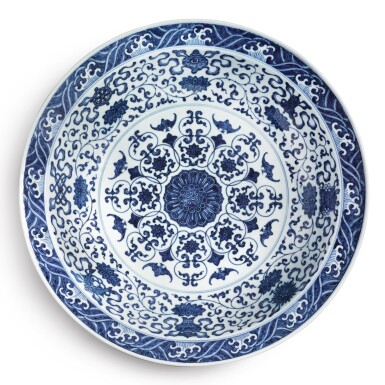Important Chinese Art
Important Chinese Art

An extremely rare and large blue and white 'bajixiang' dish, Qianlong seal mark and period | 清乾隆 青花纏枝蓮八吉祥紋大盤 《大清乾隆年製》款
Auction Closed
March 17, 08:20 PM GMT
Estimate
250,000 - 350,000 USD
Lot Details
Description
An extremely rare and large blue and white 'bajixiang' dish
Qianlong seal mark and period
清乾隆 青花纏枝蓮八吉祥紋大盤
《大清乾隆年製》款
robustly potted with shallow curved sides supported on a tapered foot rising to a flat rim, vividly painted in the center with a stylized lotus enclosed by flying bats and florets, the cavetto decorated with beribboned 'Eight Buddhist Emblems' above lotus blossom scrolls, all within a continuous band of cresting waves at the rim, the reverse with further bats swooping above turbulent waves crashing against rocks, the countersunk base with a six-character seal mark in underglaze blue
Diameter 17 ¼ in., 43.9 cm
Sotheby's Hong Kong, 29th April 1992, lot 139.
Sotheby's Hong Kong, 8th April 2011, lot 3131.
來源
香港蘇富比1992年4月29日,編號139
香港蘇富比2011年4月8日,編號3131
The present dish is impressive for its large size and carefully composed design, and no other example of this type appears to have been published. For the prototype of this dish, see a slightly larger example with a similar composition on a yellow ground, with a Yongzheng reign mark and of the period, sold in these rooms, 20th November 1985, lot 156.
The bajixiang ('Eight Buddhist Emblems') originated in India and came into China with the introduction of Tibetan Buddhism in the Yuan dynasty (1279-1368), and were immediately incorporated into the decorative arts. During the early 17th century, these Buddhist symbols became integrated with Daoist symbols and came to convey longevity. The combination of the bajixiang resting on lotus flowers and the interlocking scrolls derives from the blue and white palace bowls and stemcups of the Chenghua period (r. 1465-1487); for example, see a stemcup included in the exhibition A Legacy of Chenghua. Imperial Porcelain of the Chenghua Reign Excavated from Zhushan, Jingdezhen, Tsui Museum of Art, Hong Kong, 1993, cat. no. C52.
